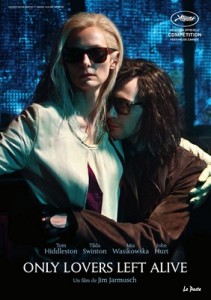film review: only lovers left alive
Only Lovers Left Alive contemplates a reunion between lovers: Adam (Tom Hiddleston) and Eve (Tilda Swinton). Having lived for what is presumably years apart, Adam is depressed and on the point of committing suicide when he receives a phone call from Eve. Eve, living in Tangier, senses Adam’s distress and returns to the crumbling city of Detroit to comfort him. Oh, and I should mention: Adam and Eve are vampires.
The vampire sub-genre has been getting a lot of attention over the past few decades, with new, sensitive, fresh blood being pumped into the category by modern updates like Buffy the Vampire Slayer, Anne Rice’s Interview with a Vampire series, and even the dreaded Twilight. All of these incarnations are contemporary takes on an old story, classically defined, as we all know, by Bram Stoker’s 1897 Gothic-horror novel Dracula. Unlike his ancestors, whom we would watch fall in love with mortals and embark upon “vegetarian” diets, Dracula was a bloodthirsty, pure-evil manifestation of Victorian-era fears.
In Only Lovers Left Alive, director Jim Jarmusch (Stranger Than Paradise, Broken Flowers) restores the vampire to its former supra-human status, rather than attempting a reinvention or – perish the thought – a humanising of his vampire characters. Nevertheless Only Lovers’ vampires remain useful avatars with which to examine human problems; Jarmusch’s film ponders our fear of morality, our strange and ill-founded lust for fame, and that old Victorian hangover: fear of female sexuality. Hiddleston’s Adam is a solitary, sorrowful musician, who has inadvertently cultivated a legendary rock-god persona by isolating himself from the human music scene. Swinton, with her otherworldly beauty, creates an engaging character out of what little meat there is to be found in the script, but Eve remains defined by her relationship to Adam, as his beloved muse.
Only Lovers Left Alive has a decidedly Victorian attitude towards sex and women, one that is perhaps an unavoidable side-effect of the source material. Literary criticism of Dracula theorises that the famous Count’s blood-sucking ways – especially since they were frequently directed at female characters Mina Harker and Lucy Westenra – were metaphorical sexual encounters. When Lucy is turned into a vampire, it is as though she has lost her virginity and all the associated purity.
Although us 21st Century folk have made great strides towards accepting the crazy notion that women have feelings too, the vampire genre (along with the rest of modern society) still worries about how women express their sexuality. Only Lovers Left Alive has two female vampiric characters; Eve, and her younger sister Ava (Mia Wasikowska). Eve is the counterpart to Adam: an angel in white leather, she is Adam’s caretaker and faithful lover. The young, impetuous, sluttish Ava is the dark side of Eve’s coin; where Eve is chaste, supportive, and tender, Ava is wild, destructive, and wont to drain dry the young man she lures back to Adam’s lair in a symbolic one-night stand.
If we read vampirism as an analogy for our culture’s sexual anxieties, then there is strong implication here that there is a right way and wrong way for women to express their sexuality. It is fine for Eve to have a sexual relationship with Adam, because their relationship is an idealised form of monogamy: a love that is literally everlasting. In contrast, Ava’s bite-them-then-dump-their-bodies approach is depicted as destructive of Adam and Eve’s relationship; as though loose sexual morals were a threat to the institution of marriage. Indeed, it is Ava’s irreverent attitude towards “sex” that is the catalyst for the film’s climax.
I would like to think that this old-world stance on extra-marital sex was inadvertent, but the film’s problematic female representation rears its ugly head in connection with the film’s other central preoccupation: the relationship between fame and art. The film’s fourth vampire is Christopher Marlowe (John Hurt) – the 16th Century playwright famous for writing Doctor Faustus, and thought by some to be the true author of Shakespeare’s Hamlet. Although the real Marlowe died before Hamlet was written, the film suggests his vampirism has enabled him to write from beyond the grave. Only Lovers Left Alive explores the idea that, when it comes to great art, the work is more important than personal gain or critical acclaim; fame, in short, is the worst thing that could happen to a Great Artist. All of Jarmusch’s vampires are preoccupied with the Arts in one form or another, with the exception of loose-moralled rock’n’roll-loving Ava. Eve reads every thing in every language, her luggage weighed down with literature. Marlowe scribbles on past death. Adam has spent his eternity mastering every instrument ever made. He is the “great artist” of the film; credited with gifting an adagio to Schubert, and composer of the post-rock funereal masterpieces around which the film’s score centres. It is worth noting that Marlowe and Adam are the creators, the composers; Eve and Ava are the consumers – the enraptured readers, the groupies at the edge of the stage. They give their attention wholly to male artistic genius.
Only Lovers Left Alive is dark in every sense of the word – dimly lit, and darkly funny. Despite the lingering ghost of Victorianism and an outdated attitude towards women’s roles in the Arts, it remains a beautiful film, one that raises interesting questions. It wonders whether an audience is necessary for art to be art. It wonders what humanity could do, if only we had all the time in the world to dedicate to learning every language, every instrument; if we had an eternity to spend, could our art make the world a better place?


